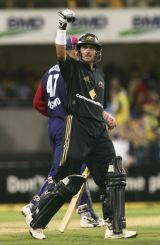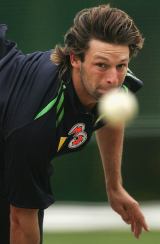
|

Michael Hussey has mastered the art of turning what is shaping up to be a mediocre total into an unassailable one
© Getty Images
|
|
After having lifted the Champions Trophy and the World Cup over the past 12 months, Australia are aiming for an unprecedented clean sweep of the limited-overs silverware.
No team is feared like Ricky Ponting's and only Glenn McGrath (retirement) and Shaun Tait (elbow injury) are missing from the triumphant Caribbean squad. Brett Lee adds more firepower after recovering from ankle surgery while Ben Hilfenhaus, the Tasmania swing bowler, is the new baby who will benefit from the experience of his first senior overseas tour.
The players enjoy the Twenty20 format, but most warn of the dangers of taking it too seriously. A potential lapse in Australia's usually unbreakable mental spirit is one of the few things offering their rivals hope.
Home truths
The Test and one-day regulars have played only a handful of these matches - Australia have three wins and two losses in Twenty20 - but the state representatives have been part of the two-week domestic competition over the past two years. After early scepticism when the game was born in England, Australia raced to join in and quickly organised the
first international, which they won against New Zealand.
Strengths
Power hitting is the major weapon, but the real problem for opposing teams is the depth of Australia's batting. Adam Gilchrist and Matthew Hayden intimidate in any game, Ricky Ponting struck a 55-ball 98 not out in that game against New Zealand, showing he could be even more brutal when he thought only of free swinging; and Michael Clarke can find gaps with ease.
Then come the big hitters: Andrew Symonds and Michael Hussey average a six every second ODI, while Shane Watson's 145 World Cup runs came at the staggering strike-rate of 170. Over 20 overs at least one of these men will fire, and with useful contributions an out-of-reach target can be arranged in half an innings. The two Brads, Hodge and Haddin, will provide capable back-up, and the bowlers will be ready to exact revenge for the severe treatment they will receive when they bowl. Nathan Bracken has become a key man in the absence of McGrath and his swing and across-the-seam variations make him one bankable ingredient.
 Australia have the best balanced side as well as the side best placed to handle any situation as it occurs
Australia have the best balanced side as well as the side best placed to handle any situation as it occurs
 Ian Chappell |
Weaknesses
The bowling is not so much a weakness as an unknown. In the lead-up to the tournament the fast men travelled to the Centre of Excellence in Brisbane in an attempt to devise strategies for the carnage they would see in South Africa. However, plans the length of the alphabet will be needed to cope with the avalanche of batsmen with freedom to pummel.
Lee's speed can be match-winning or -losing, Stuart Clark is desperate to show his limited-overs output can be as immaculate as his Test work, and Mitchell Johnson and Watson are still trying to prove they belong as bowlers.
Slow bowling would appear to be a casualty of the condensed game, but it has achieved some success on the domestic scene and Australia have Brad Hogg, Symonds and Clarke to call on.
Player to watch
Michael Hussey experienced his first international slump at the World Cup, leaving the Caribbean
with only 87 runs - and is ready to rectify the situation if his team-mates allow him the batting time. In the past two years he has improved on the one-day international finishing role made famous by Michael Bevan and is able to turn what is shaping up as a mediocre total into an unassailable one with clean striking and clever running.
Dark horse
Ben Hilfenhaus is the only unknown player in the squad after impressing with 60 Pura Cup wickets for Tasmania last season. A swing bowler, he operates around 140kph and is a severe threat. One-day and Twenty20 international debuts came in 2006-07, but he missed the World Cup squad and was a late addition to this outfit after Tait's injury failed to heal.

|

Ben Hilfenhaus swings the ball at pace and could prove to be a handful
© Getty Images
|
|
Ian Chappell's take
There's bad news for the rest of the cricket world - Ponting has announced that Australia are taking the Twenty20 World Championships seriously and are heading to South Africa with the intention of winning the tournament.
Australia have the best balanced side as well as the side best placed to handle any situation as it occurs. The fact that the bulk of the team are in the Test side emphasises the point that a good cricketer should be able to adapt to any format of the game.
They have powerful hitters in Hayden and Gilchrist at the top of the order, and then they have Symonds and Watson in the middle. Gilchrist, Hayden and Ponting are well equipped to take advantage of the field restrictions in the first six overs. The bowling has plenty of variety with the pace of Lee, the steadiness of Clark and Bracken, and the wrist-spin of Hogg. In the field they have run-out specialists in Ponting, Symonds and Clarke, and plenty of fast young legs and strong arms to patrol the outfield. In other words, Australia is a team made of complete cricketers - exactly what you would expect from a strong, international side.
I expect Australia to reach the final, and with their record in all forms of the game in the last decade, I'd be surprised if they lost. However, sooner or later it's going to happen - a Ponting-led side is going to falter in a major limited-overs competition. Rating: 8/10
Peter English is the Australasian editor of Cricinfo

